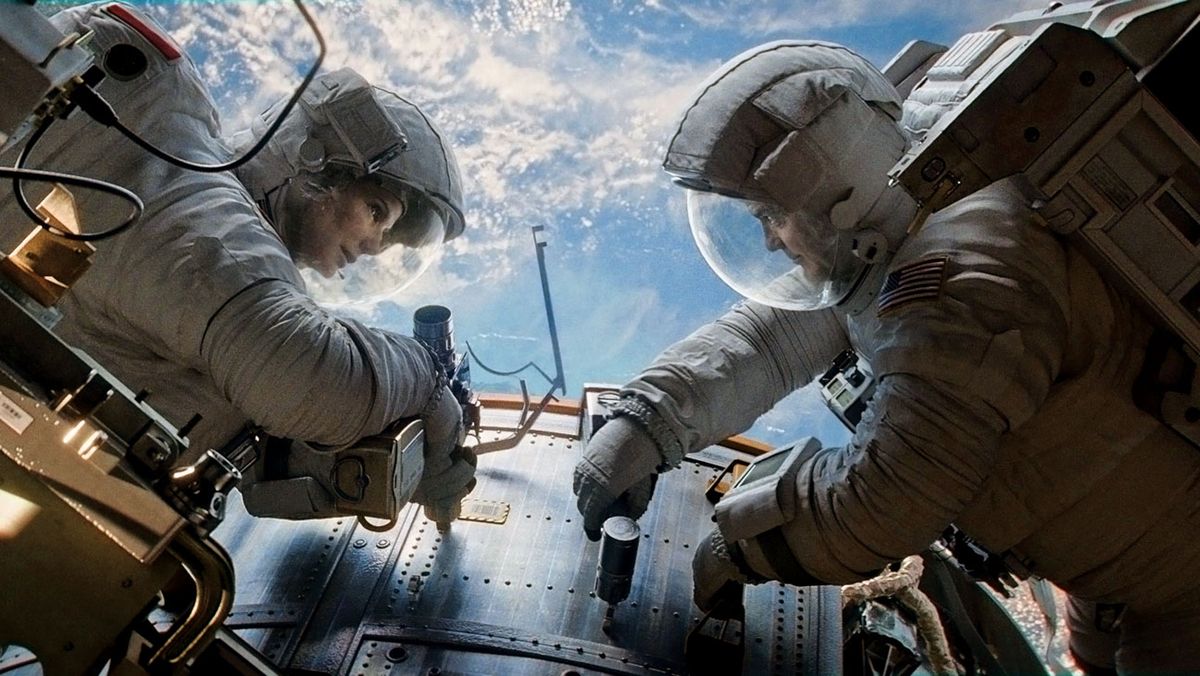"Gravity" Touted as the Future of Cinema

I’ve never seen a film quite like “Gravity”. It’s a thrill ride to end all thrill rides, never letting up in subjecting its characters to situations from bad to worse during its 90-minute running length. “Gravity” is, for those who want a no-frills blockbuster, nerve-wracking in a way that few films are. This is a true edge-of-your-seat motion picture. In fact, it’s much more than that. “Gravity” is a film about mankind trying to control that which they may have no business controlling, an existentialist examination of survival in which every choice could mean life or death and an eerie, dread-inducing humanist exploration of what survival against impossible odds entails. “Gravity” is a film that tries to challenge what film can be on a technical level. More than that, it is a film that tries to transform our visual understanding and appreciation of Earth and the outer galaxies. The film plays to populist sensibilities and attempts to earn its large budget back by showcasing destruction and visual splendor to an extent that no film has this year. It’s “2001: A Space Odyssey” meets “Star Wars.” It’s not as eerie as it could have been, but for all its ambition, “Gravity” is almost entirely successful. It’s the rare film that will likely be both nominated for Best Picture and skyrocket into the hundreds of millions at the box office. “Gravity” has been touted as the future of film-making, and while I have reservations about the idea of all future films being as CG-infested as this one, this bold, singular, un-compromising film will be remembered as a game-changer many years in the future.
The story of director Alfonso Cuaron’s labor of love (it’s taken him over seven years to make), is actually pretty simple. Astronauts Matt Kowalski (George Clooney) and Ryan Stone (Sandra Bullock) find themselves stranded in space with little chance of survival after debris from a satellite explosion sends them hurtling into deep space. The meat of the piece is a survival story in a long line of literary and filmic works that attempt to capture the essence of knowing one’s imminent death and fighting to survive regardless. The major difference between that tradition and “Gravity” is of location. “Gravity” gives the final frontier new life. This is the type of film the word “visionary” is coined for. It captures director-writer Alfonso Cuaron’s continuation of his unbroken track record as well as claiming new territory for not only himself but also film as a visual medium. Not since “Avatar” has CG technology enhanced a film’s quality this much. Unlike Cameron’s film, Cuaron is wise enough to let his visuals do the talking: he doesn’t have much of a plot, because it isn’t necessary. The film’s story is its setting. And if film is a medium in which the doctrine “show, not tell” reigns supreme, this is its modern manifesto. With “Gravity,” “show” means something entirely new.
Despite being, nominally, a two-person show, the real star of “Gravity” is the environment itself: space. Expansive and distant yet immediate and personal, Cuaron’s depiction of space is equaled only by the depiction in “2001: A Space Odyssey”. Cuaron’s commitment to his vision of space as a frightening unknown that humans desire to control is beyond commendable. His subjective camera conveys everything we need to know. The unbroken opening 20-minute take is a highlight as the camera spins around our main characters, at first leisurely and later with force and desperation, to mimic their emotions. At one point, before the take ends, the camera slowly, deliberately and exhaustingly moves within a character’s helmet and then smoothly transitions to the character’s viewpoint, to present space from their perspective. We aren’t just watching a location in “Gravity” — we are transported to it. And Cuaron’s skill isn’t purely visual; the sounds of silence permeate the film and fill it with a sense of majesty and dread. Everything we do hear is all the more piercing and jarring because of this. It’s often hard to believe “Gravity” wasn’t really filmed in space.
Speaking of sound design, dialogue is at a premium in “Gravity.” Cuaron’s screenplay isn’t the defining feature of the film, but it’s no hindrance either. The first 20 minutes are suitably playful, but after things go awry, the presence or absence of dialogue literally becomes a matter of life and death. On one hand, speaking consumes oxygen, which becomes a precious resource, but as Bullock’s Stone and Clooney’s Kowalski continue to talk with one another even while physically separated, we begin to see that sometimes what they lose in oxygen they make up for in sanity. Everything, including hearing a dog bark over an intercom, takes on greater meaning than it would otherwise. One moment in particular stands out: Stone, simultaneously resigning herself to death and continuing to fight for survival, delivers a monologue to herself about survival, spirituality, life after death and human interaction. In any other film, this would be cringe-inducing. Here, however, Bullock’s resigned facial expression and uncommitted tone and Cuaron’s framing transform the speech into something far more disquieting. As she continues to speak lines we’ve heard movie characters say all too often, we begin to realize that she doesn’t necessarily believe anything she’s saying, but it gives her something to say, to hear a voice for one second longer, even if it is her own. She’s telling herself what she wants to hear even though she knows she’s probably wrong.
And, of course, it’s impossible to write about “Gravity” without discussing Clooney’s, and in particular, Bullock’s contribution. Clooney is actually mostly out of the film by the halfway point, allowing Bullock to take center stage, and therefore it’s telling that one of the biggest strengths of “Gravity” is its acting. Don’t get me wrong, Clooney gives a strong, admirable performance, but this is really Bullock’s picture. It’s not a masterful performance, but it comes close, conveying doubt, tension, dread, hope and numerous other emotions, sometimes within seconds of each other. It’s not only a demanding physical performance, but also an emotionally rigorous one, as Bullock uses her eyes and face to convey what she often cannot with words.
Gravity is a singular experience for most of its running length. More than any other film, it makes us feel “space,” even as it acknowledges that we can never understand it. Every breath the characters take is one we take with them, and the sense of verisimilitude is as high as that within any film released this year. That is, for most of its running length. Toward the end of the film, we start to gain an understanding of its rhythms and motions and begin to understand where it’s heading. The air of existential dread which permeates much of the film doesn’t dissipate entirely, but it is somewhat lessened as the film hurtles (literally) toward its conclusion. The final ten minutes retain the tension, but it’s more due to the quality of the filmmaking than the plot. If “Gravity” has a misstep, it lies in its final scene. I won’t explicitly spoil anything, but it’s the only moment when the film feels self-indulgent. There’s even a choir. But, for most of its running length, “Gravity” is the most thrilling experience I’ve had in a theater in a long, long time and blows any would-be blockbuster from this summer out of the water. Is it the future of filmmaking? That’s a conversation to be had later on, but right now, in 2013, you should definitely see “Gravity.”





Comments ()